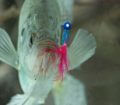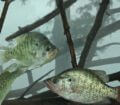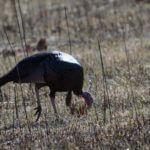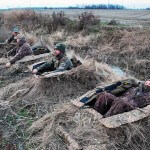John’s Note: A couple of weeks ago at the Prattville, Alabama, Bass Pro Shops’ (www.basspro.com) Crappie Masters’ (www.crappiemasters.net) Alabama Championship, a father-and-son team, Billy and Scott Williams, from Cochran, Georgia, claimed the title. The weather was warm, and the crappie were moving into their summertime pattern. Although many of us may believe that springtime is the best time to catch crappie, these two men showed us how to catch crappie all summer long. Scott Williams has been fishing with his daddy, Billy, ever since he was a little boy. I told Scott, “I need you to catch a couple of crappie for me to take pictures of,” before the tournament started, and Scott answered, “No problem.” We motored the boat over to a styrofoam floating dock that had holes no more than 6-8 inches above the water. Then Scott put on a show I’ll never forget.
John E. Phillips: Scott, why do you like to shoot floating docks with a small crappie jig and 2–4 pound test line?
Scott Williams: Floating docks are pretty much solid structures, but they do have small holes all the way around them. When the sun gets high in the sky, and the weather’s really hot, crappie want to go to these floating docks where they’ll find the most and the darkest shade, and where small bait fish tend to congregate. The little-bitty holes that no one thinks he can get a jig or a minnow up under go relatively unfished by most crappie anglers. If you’re willing to practice shooting docks, you can get good enough to shoot or skip a jig under those tiny holes, so that they’ll land in the center of the dock. Then as you let your jig free fall, most of the time, if a crappie is under the dock, it will take the jig on the fall. If not, you can jump it up off the bottom a time or two and let it fall back again, and the crappie will get it. Most of the time, you won’t feel the strike. You’ll just see your line twitch or see your line stop. Then you set the hook. The real key to successful dock shooting is to either shoot or skip a jig as far as you can under those floating docks.
 Phillips: Scott, walk me through how you shoot docks.
Phillips: Scott, walk me through how you shoot docks.
Scott Williams: When I release the jig and I know I’ve made a good shot far up under a floating dock, I watch my spinning reel. When the line stops spooling off the reel, I flip my bail and engage the reel. As quickly as I can get the bail closed, I then focus on the line going into the water. Sometimes or often as soon as the jig hits the water, a crappie will strike or may take it while it’s still falling. Or, a crappie may attack when the jig gets near or hits the bottom. Sometimes you can feel the bite. But most of the time, you have to see the bite (when your line twitches). I’ll set the hook when I see the line jump. This tactic allows you to fish the entire water column from the surface of the water all the way down to the bottom.
The Alabama River out of Cooter’s Pond near Prattville has both white crappie and black crappie. White crappie will hold under a floating dock just like black crappie. Black crappie tend to prefer to suspend in the water, but white crappie tend to relate more to the bottom than the black crappie do.
Phillips: When the jig hits the bottom, what do you do?
Scott Williams: I jump the jig off the bottom, let it fall back, then slow reel the jig back to the boat, hop it up, let it fall and slow reel. When I get a bite, I remember what I’ve done and note about where in the water column the bite has occurred. So, I repeat the same thing I’ve done when I’ve gotten the bite.
Phillips: On most floating docks, there will be three small holes on the front side of the dock, and three small holes on either side of the dock. Why do you shoot the center hole first?
Scott Williams: I want to get my jig to the darkest spot under that dock, and the center of the dock will always be the darkest spot under the dock. That center hole under the dock always will be the first place I want to put my jigs.
Phillips: How many crappie can you catch off a floating dock in the middle of the day in the summertime?
Scott Williams: Before I’ve caught as many as 30 or 40 crappie off a small single floating dock. Sometimes you may not get any crappie, or you may only get one or two. However, if you find a really-good dock, you can catch a lot of crappie.
 Phillips: What color jigs do you like to shoot under docks?
Phillips: What color jigs do you like to shoot under docks?
Scott Williams: Red, yellow or chartreuse, but that’s just my opinion. I don’t have any way to prove it, but I don’t think color matters when you’re shooting under a dock, because where the crappie are holding is usually pretty dark.
Phillips: When you started shooting this dock, you caught some small crappie first. Then you caught some big crappie. What size of crappie does a dock usually hold?
Scott Williams: Most of the time, I’ve found that mixed-size crappie are under a dock. Often when I make the first two or three shots under a dock, I’ll catch small crappie, because they’ll run to the jig the fastest. As long as I’m catching crappie, I’m going to continue to shoot the dock, until I feel like I’ve got a pretty-good idea about the size of crappie holding under the dock.
Phillips: How far do you try to stay away from the dock?
Scott Williams: I try to hold my boat 12–15 feet away from the dock. I never turn my trolling motor blades toward the dock, so, my motor won’t prop wash the dock.
Phillips: Scott, you said you can tell from looking at a dock which hole under that dock usually has the most crappie. How do you do that?
Scott Williams: When you look at a floating dock, look just above the holes. If a lot of dents are above certain holes, you’ll know that hole has been shot many times by dock shooters. The holes that have the most dents above them generally will be the holes where most dock fishermen have caught the most crappie. Looking for the dents above the holes is one of those little details to look for to help you catch more crappie. Those dents will look like little-bitty BB’s have been hitting above the hole.
Phillips: How do you shoot a dock?
Scott Williams: I make sure I hold the head of the jig with the hook pointing away from my fingers. Next with the hand that I hold the rod and reel with, I flip the bail on my spinning reel to hold the line on my index finger. Then I pull the jig back, load the rod and turn loose of the jig. As the jig springs forward, I release the line from my index finger. Click on the link to the video below, and you can see how I shoot docks, the kind of docks I like to shot and the size holes I’m shooting with my jigs.
Editor’s Note: On day 1 of the tournament, the Williamses weighed in seven crappie for a total of 12.35 pounds. On day 2 of the tournament, they weighed in seven crappie for a total of 12.02 pounds. The second place team at the final weigh-in had 1 pound less than the Williamses.
 Also, if you’d like to fish Cooter’s Pond https://www.facebook.com/pages/Cooters-Pond-Park/146063642088959 near Prattville, Alabama, be sure to stay at the Hampton Inn and Suites, http://hamptoninn3.hilton.com/en/hotels/alabama/hampton-inn-and-suites-prattville-MGMCFHX/index.html, phone: 1-334-285-6167.
Also, if you’d like to fish Cooter’s Pond https://www.facebook.com/pages/Cooters-Pond-Park/146063642088959 near Prattville, Alabama, be sure to stay at the Hampton Inn and Suites, http://hamptoninn3.hilton.com/en/hotels/alabama/hampton-inn-and-suites-prattville-MGMCFHX/index.html, phone: 1-334-285-6167.
To learn much more about crappie fishing, get John E. Phillips’ Kindle eBooks and print books, “Crappie: How to Catch Them Fall & Winter,” “Crappie: How to Catch Them Spring and Summer,” “Catch Cold Water Crappie Now” and “Catch Crappie All Year: Fishing a Single Pole, Using No Boat and Farming Crappie” by clicking on each, and you also can go to www.barnesandnoble.com.
To receive and download for free “The Crappie Catchers’ Cookbook” by John and Denise Phillips that offers free recipes, go to https://johninthewild.com/free-books.










